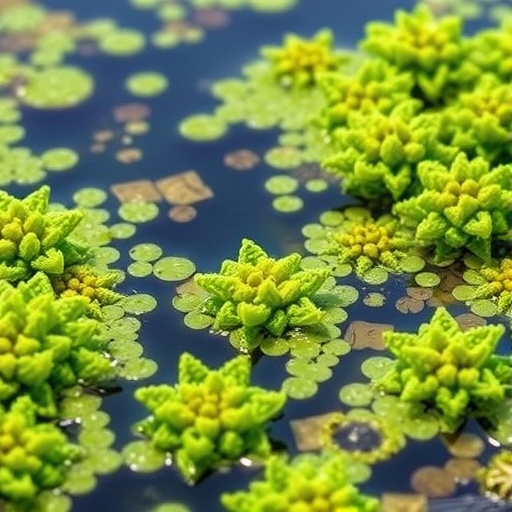In recent years, the quest for sustainable wastewater treatment has gained traction among environmental scientists and engineers. The escalation of pollution levels, particularly phosphorus discharge from industries and agricultural runoff, poses a significant threat to aquatic ecosystems. To tackle this, researchers are increasingly turning to innovative solutions involving microalgae. A groundbreaking systematic literature review and multivariate analysis recently published in the journal Environmental Monitoring and Assessment delves into the efficacy of utilizing microalgal cultivation in photobioreactors for phosphorus removal from wastewater.
The research led by Bezerra, Fontana, and Arantes presents a comprehensive overview of existing methodologies, experiments, and results in the field of microalgal phosphorus removal. The report meticulously dissects over a decade’s worth of literature, showcasing a vast array of experimental setups and outcomes across various geographic locations. This rigorous assessment indicates that leveraging microalgae in photobioreactors could serve as a transformative approach to not only detoxify wastewater but also potentially recover valuable resources from it.
Microalgae’s natural ability to assimilate phosphorus while thriving on various wastewater components makes it an attractive candidate for bioremediation. These microorganisms can utilize phosphorus for growth, effectively reducing its concentration in polluted waters. The systematic review reveals that different species of microalgae have varying efficiencies in phosphorus uptake, influenced by factors such as light intensity, nutrient availability, temperature, and photobioreactor design. The statistical analysis conducted by the researchers highlights these correlations, enabling a clearer understanding of optimal conditions for phosphorus removal processes.
Another fascinating aspect of microalgal cultivation in photobioreactors is the potential to generate biomass that can be converted into biofuels and other bio-based products. This dual advantage positions microalgae as a multifaceted tool within the circular economy paradigm, addressing both waste treatment and resource generation. The researchers emphasize that integrating phosphorus removal strategies with biomass production could lead to economically viable and environmentally friendly solutions to manage wastewater.
Furthermore, the review intricately explores the technological advancements surrounding photobioreactor designs that enhance algal growth and phosphorus absorption. Whether dealing with tubular, flat-panel, or hybrid systems, the design greatly impacts light penetration, gas exchange, and overall biomass productivity. For instance, recent innovations have introduced optimized light management strategies, ensuring that algal cells receive adequate sunlight while minimizing shading effects. This optimization drives the uptake rates of phosphorus and improves overall treatment efficiency.
As urban and industrial landscapes continue to expand, addressing phosphorus pollution through microalgae becomes an increasing priority. The findings of this literature review underscore the urgency with which researchers must address these environmental challenges. They advocate for collaborative efforts among communities, industries, and policymakers to promote the integration of microalgal technologies in wastewater treatment facilities. With the looming threat of climate change and its effects on water bodies, timely intervention through sustainable practices becomes imperative.
The implications of this research extend beyond mere academic interests. As water quality is directly tied to public health, improving wastewater treatment methods has vital repercussions for communities across the globe. Polluted water bodies lead to toxic algal blooms, which can cause fish kills, impair drinking water quality, and affect recreation. Therefore, harnessing microalgae for phosphorus removal not only elevates water quality but also encourages healthier ecosystems, creating an environment conducive to both human and ecological well-being.
Critics, however, may caution against relying solely on microalgae technologies without considering the complete picture of wastewater treatment. The review addresses this concern by discussing potential scalability issues, economic feasibility, and the need for synergistic approaches that integrate microalgal systems with existing wastewater management infrastructures. The path forward is clear: it requires a multifaceted approach, combining innovative technologies with robust regulatory frameworks and community engagement.
The scientific community is eager to witness further trials and longitudinal studies that cement the role of microalgae in wastewater treatment. The comprehensive statistics presented in this review serve as a foundational tool for future research endeavors, inspiring both academic inquiry and industrial implementation. The hope is that emerging research will continue to optimize microalgal bioprocesses, paving the way for large-scale applications that can reliably mitigate phosphorus pollution.
As the paper concludes, the authors call upon environmental engineers and water quality experts to continue exploring the untapped potentials of microalgae. With the wealth of knowledge amassed through systematic review, new research trajectories can emerge, leading to improved technologies. Moreover, as the global conversation about sustainable practices continues to evolve, addressing wastewater treatment through microalgal solutions can become a focal point for innovation and policy development.
In summary, the systematic review and analysis presented by Bezerra et al. provide a glimpse into a promising future where microalgal cultivation can play a central role in phosphorus removal from wastewater. These findings not just represent progress in environmental science but also ignite a larger movement towards sustainable practices in managing the Earth’s vital resources, ultimately contributing to a healthier planet for generations to come.
Subject of Research: Microalgal cultivation for phosphorus removal from wastewater
Article Title: Phosphorus removal from wastewater by microalgal cultivation in photobioreactors: a systematic literature review and multivariate analysis.
Article References:
Bezerra, S.S., Fontana, L., Arantes, C.C. et al. Phosphorus removal from wastewater by microalgal cultivation in photobioreactors: a systematic literature review and multivariate analysis.
Environ Monit Assess 197, 1182 (2025). https://doi.org/10.1007/s10661-025-14524-2
Image Credits: AI Generated
DOI:
Keywords: Microalgae, phosphorus removal, wastewater treatment, photobioreactors, sustainable practices.




